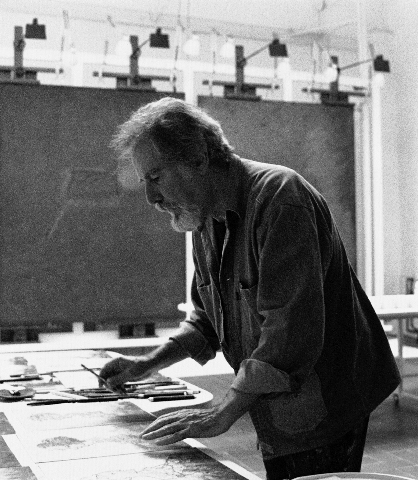Cuixart, Modest

Modest Cuixart was born in Barcelona in 1925. He decided to honor his family’s legacy by majoring in medicine, yet after two years he dropped out to study painting instead. Together with his cousin Antoni Tàpies, Joan Brossa, Joan Ponç, the philosopher Arnau Puig and Joan Tharrats, they founded the magazine Dau al Set in 1948. It was created during Franco’s regime and it fought for visual modernity based on magic and reality’s mystery.
In 1950 he received a scholarship from the French Institute to continue his art studies in Paris, where he lived with Tàpies and fell in love with the work of Dubuffet and Fautrier. However, soon after he moved to Lyon and explored different materials, like pyrography, encaustic and grattage. Although it was dripping that greatly influenced his work for the next decade. In Lyon, he also had the opportunity to meet various gallerists like Marcel Michaud and René Drouin, who introduced his paintings to the Parisian art world by curating different exhibitions.
The Catalan artist used to incorporate a wide variety of objects in his paintings, a characteristic typical of European informalism that emerged in that period. His renowned dripping works were characterized by metallic and dark tones, together with deconvoluted figures. This material informalism caused his works to be incredibly individual and personal. However, at the beginning of the 60s, he abandoned informalism to focus on more human and natural concepts, a drastic change that was influenced by Bertold Brecht. In the 70s and 80s, he elevated these concepts and emphasized a strong figurative style that was marked with an erotic and magic tendency.
Throughout his life, Cuixart had undeniable success, while many critics considered him the authentic innovator of informalism. Essays explaining and discussing his work were published in all the big art magazines of the time, such as Art Actuel, Quadrum, Cimaise, Dan Kunstwerk or Ars Magazine. On the other hand, he was awarded with the Gold Medal of the prestigious Swiss prize for abstract painting and with the prize for painting of the V Biennale of Sao Paulo.
From the 50s until his passing in 2007, he exhibited in museums like the Museu de Mataró, the Carce des Beaux-Arts of Paris, the Museo Nacional de Arte of Buenos Aires, the Tate Gallery of London, or the Guggenheim Museum of New York. Nowadays, his work remains in the permanent collections of the MOMA, Museo Reina Sofía or MACBA.